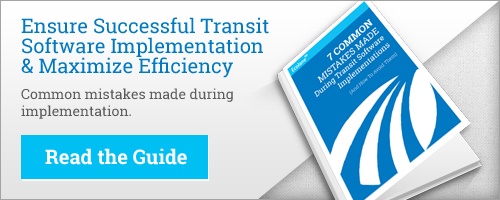When the time comes to consider implementing new software for a transit agency there are many essential factors to consider. Among the most important considerations to think about are the pitfalls associated with the decision to integrate new routing & scheduling software into an organization. Without understating the many benefits that can accompany the successful transition of a new software implementation, setting up an organization with less-than-desirable adoption rates and creating customers who are no longer happy become major headaches for an agency.
Over the next few weeks, Ecolane will be exploring the issues that arise when the decision to change transit software is on the table.
Communication
Communication is a key component in any relationship but perhaps even more when it comes to interacting with clients. A clear and concise communication of changes being made during the implementation of new transit products is an essential component for success and demonstrates why this audience is among the first groups to notify of changes. Take the time to understand what information should be shared with clients and make sure to take into account when the best time to relay the information would be. Be proactive in the approach, too. A few examples include:
- Work with software providers to identify the changes clients might expect. Any alterations in the reservation process impact one of the most important interactions between transit agencies and their riders. If the process to reserve is different after launching a new system then make sure your customers are aware of those changes.
- If your primary service is to move people from point A to point B, it’s important that management of pick-up and drop-off times aren’t enacted before informing riders. On question to ask yourself is do they need to plan their schedule differently? Remember, the plan to make the experience more efficient can actually feel more difficult for some.
Stuck In Their Ways
Change is always a difficult hurtle to cross. Most agencies have a number of operational policies that are outlined for their riders. As customers adjust to new policies, some rules can become inconsistent if exceptions are made. Decide what specific policies to enforce then determine what exceptions are being made on a regular basis. Then use that knowledge to better communicate to riders.
Not surprisingly, operational changes may be required after new software is put into place. Changes like these can negatively impact the customer so the best strategy is to be proactive and allow riders to get used to the changes that have been made.
We hope after reading this short article as well as the future articles in the series, organizations will
- Know the issues
- Know how to navigate those issues
- Know that changes to software and related processes don’t have to be painful endeavors.
Understanding the advantages of new software is as important as implementing the software itself.
Please contact us at Ecolane with questions about software implementation or transportation software solutions in general. To get a thorough idea of the common mistakes of software implementation and how to overcome them, please click below.
About the Author

Ecolane
Read Ecolane's blog articles for perspective, opinion and information on transit and paratransit issues.
%20(200%20x%20100%20px).png)

